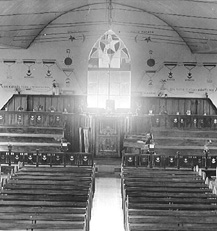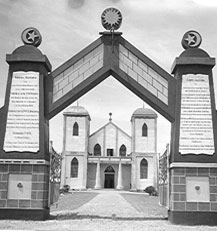

Home | E
Turning of the Sod | Spiritual Opening Temple | Bishop Juji Nakada
T.W.Ratana Mangai | Ihu Karaiti Ate Matua Ora | Maramatanga | Kawenata
Masters Thesis 2003: Last of The Great Phophets, Sacred Icons of the Ratana Movement and Ratana Church. All information sourced from World Tour Journals, Personal Family Albums Books, Photos, News Clippings, World Tour Newpapers, Old Film Black and White Footage, Te Whetu Marama O Te Kotahitanga, Te Rongo Pai Hou A T.W.R.Mangai, (Uri Whakatupuranga The Ratana Research Archive Centre Ratana Pa) online web search Japan, Great Britian, United States America, Australia, New Zealand. Information from personal collections from the Morehu around New Zealand, and those living in Ratana Pa.Temepara
Tapu: Temple Project
The Holy Temple represented symbolically the
House of God, a place of salvation for people on Earth. T.W.Ratana Mangai
always said that all true Morehu would always remember the Temple and
cast their minds and hearts and hearken to it in times of need, sadness,
sickness and problems of human ailments. For
therein dwelled the spirit of the Lord. In December 1926, to January
1927, was completely dedicated to the construction of the Holy Temple.
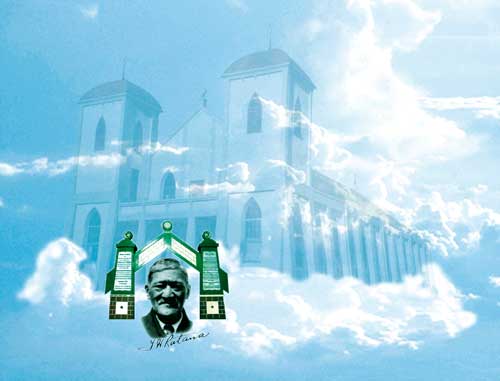
(1925) Temple Foundation
On the 5th July 1925, at 11.00.am a light mist of rain began to fall in Ratana Pa, T.W.Ratana (Mangai) began to speak to the people indicating they were witnessing a spiritual occasion. This is known as the day the Mangai sealed the Church in the name of Jehovah, Father, Son, Holy Spirit, Faithful Angels, and their Mouthpiece
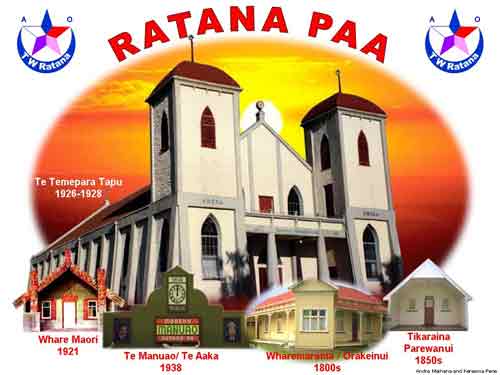
Maori Version
“He pata ua no te Rangi ka Hiiritia ki te
Whenua, He auahi no te Whenua ka hiiritia ki te Rangi.”
“Ka hiiritia nei e ahau to koutou Haahi I tenei ra ki runga ki te Toka Kamaka, Matua, Tama, Wairua Tapu me nga Anahera Pono me te Mangai e kore ai e taea te whakakorikori, te whakangaueue.”
English Translation
“A minute particle of rain from Heaven
falls and is received by the earth becomes part of the earth; a wisp
of smoke (or vapour) from the earth rises and is received by
the heavens and becomes part of the heavens.”
“Like wise with your Church which, on this day, I commit, and seal, as part of the solid rock foundation of the Father, Son, Holy Spirit, the Holy and Faithful Angels and the Mouthpiece, upon which it shall rest unshakeably and undeniably.”
Turning of the Sod
On the 23rd May 1926, at 2.30pm, T.W.Ratana Mangai dug the first Sod on the day of Pentecost where today the Temple stands. Although the weather was stormy and wet underfoot, this did not deter the Morehu from their purpose. After the opening hymn and prayers conducted by the “Mangai” he spoke to the congregation saying.
“You have been asked to gather here, the place where it has been decided the Temple will stand. Right here where I now stand will be the platform from which the Apostles (Apotoro) will preach when the Temple is completed. Here you will see an important and highly precious possession of your Church take shape. Through this Temple you may project your hearts and prayers to God (Ihoa) in fervent and true prayer that shall not be hurt by the ills and misfortunes of this world, and that this Temple shall be the resting place of God’s (Ihoa’s) breath.”
Although the weather was stormy and wet underfoot, this did not deter the Morehu from their purpose. After the opening hymn and prayers conducted by the “Mangai” he spoke to the congregation saying. (WM Te Tai, 1926: pg2)
English Translation: “You have been asked to gather here, the place where it has been decided the Temple will stand. Right here where I now stand will be the platform from which the Apostles (Apotoro) will preach when the Temple is completed. Here you will see an important and highly precious possession of your Church take shape. Through this Temple you may project your hearts and prayers to God (Ihoa) in fervent and true prayer that shall not be hurt by the ills and misfortunes of this world, and that this Temple shall be the resting place of God’s breath.”Work began on the Temple on 23rd May 1926, and it was built by voluntary labour, the materials being purchased with funds provided by the people. During this stage of the work on the Temple Mr Ratana spoke many quotations regarding the Temple and its significance to encourage his people to be steadfast in their faith. During this stage of the work on the Temple Mr Ratana spoke many quotations regarding the Temple and its significance to encourage his people to be steadfast in their faith. The Temple was always a place of worship in which Gods spirit would dwell. The opening and the consecration of the Ratana Temple marked a simular comparison to the people of Israel, which refers to Ezekiel’s vision of the Temple (Ezekiel 40:1-49) and (Ezekiel 41:1). (WM Te Tai I, 1926: pg2)
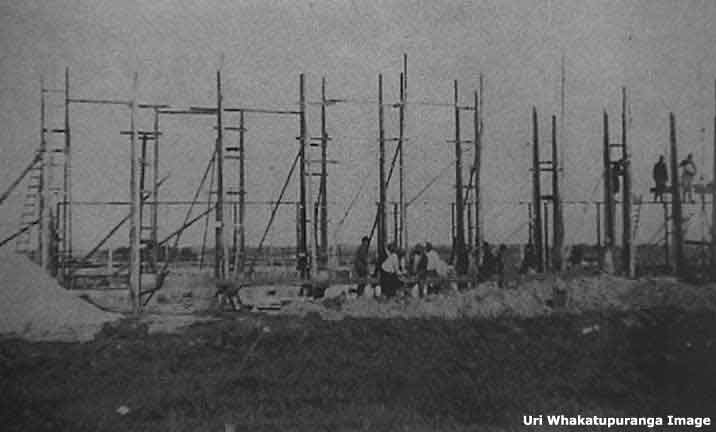
The Prophet Ezekiel was looking for salvation for his people. In question the same could be said for the Ratana’s Temple! T.W.Ratana had a vision, in which he saw a Temple, a most magnificent Temple, to be called “The House of God.” In this house, God could be Honoured and Glorified. T.W.Ratana believed in something far greater and nobler for his people, thus the Temple was built to fulfil the vision that was given to him from the Holy Spirit. In this Temple, he placed symbols and words, which teach his people to look forward to the God of Heaven and Earth. The followers would marvel at their most wonderful Temple and look upon it as a receptacle dwelling place of the breath of God. T.W.Ratana believed in something far greater and nobler for his people, thus the Temple was built to fulfil the vision that was given to him from the Holy Spirit. In this Temple he placed symbols and words, which teach his people to look forward to the God of Heaven and Earth. The followers would marvel at their most wonderful Temple and look upon it as a receptacle dwelling place of the breath of God. (Akoranga Anaru, 1997: pg66)
Maori Version
(T.W.Ratana) Anga mai o koutou whatumanawa ki to koutou Temepara, kei
konei te whakaoranga mo koutou
English Translation
(T.W.Ratana) Preserve in your hearts your Temple, for here is your Salvation.
He always said that all true Morehu would always remember the Temple
and cast their minds and hearts and hearken to it in times of sadness,
sickness and need. (Akoranga Anaru, 1997: pg76)
By 1926, Ratana, work increased with great intensity as he continued his preaching and healing work, and stilled travelled around visiting his people making them converts, visiting many Pa’s and towns in Wanganui-Rangitikei, Hawkes Bay, Taranaki and Taitokerau districts. He achieving great results delivering Gods divine message to Maori and many over cultures throughout the world.
On the 4th February 1926, Wiremu Ratana’s aunt Mere Rikiriki, the Maori Prophetess arrived at Ratana Pa to sign T.W.Ratana Mangai’s Kawenata (covenant) to become a member of the Ratana Church. One month later, on the 14th March, Mere Rikiriki passed away at Parewanui. She will always be remembered as a woman prophetess who was in the company of the likes of Te Whiti and Tohu Kakahi from Parihaka, Tawhiao and the aunt of the most Charismatic Maori leader that has moved Maoridom; Tahupotiki Wiremu Ratana.
By 1926, there were approximately 110 Apotoro (Apostles), 500 Akonga and 500 Awhina doing Church work. During 1926, T.W.Ratana was appointed President of the Kotahitanga, and by May that year, the Kotahitanga began to implement specific policies and bylaw. There were 109 Districts and Committees (Komiti Takiwa) that were set up as well as 43 Sub-Committees (Komiti Whaiti) with an average of 10 members each. Those committees were responsible for running the business of the Movement and Church were required to make regular reports of their operations to headquarters. In the latter years other auxiliary committees had surfaced.
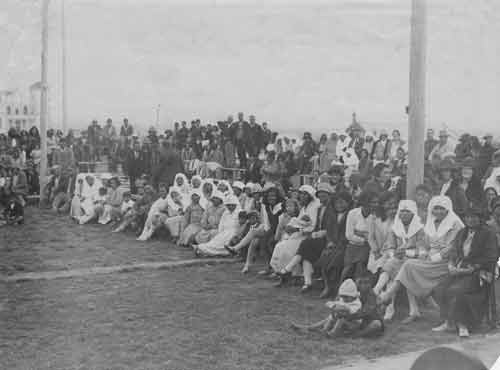
With the organising of Ratana Pa and its affairs the task of seeing that, his people throughout the country were adequately catered for. September 1926, Pepene Eketone gave an update on the documents of the Kotahitanga Land Reform plan (Huri Whenua) of which the Districts committees (Komiti Takiwa) and Sub-committees (Komiti Whaiti) National Police and National Health monitors would begin to assist in managing and co-ordinating these affairs. The first committee Marae was set up on the 27th May 1926, the committee being the headquarters of the Ture Tangata work in the Movement and Church. The first Post Office and the Ratana Railway Station were also erected in Ratana Pa.
(WM No.1867-68, October/November 1981: pp-2-3)
During Ratana’s Tai Rawhiti tour November 13th 1926, the sisters or nurses (Neehi) whose job is to visit the sick and assist the Apostles in their work, the name Neehi was changed to Awhina (Helpers). This was in response to the New Zealand Health authorities’ complaint to the Kotahitanga At the end of 1926, T.W.Ratana delivered a message to his Morehu concerning them and their faith. This is the following speech he delivered to his people concerning their faith.
(T.W.Ratana) “Ko te hunga e pekepeke nei ki waho o te tikanga, kia mahara koutou, ahakoa ahu kouou ki whea, o, uru atu ana ki tewhea Haahi, kia mahara ano, kua oti ke koutou te parani ki te parani o Ihoa, a, he wa tona ka hoki mai ano koutou ki te waahi I paranitia ai koutou.”
(T.W.Ratana) “No matter where they travelled, or what church they joined, it must be remembered, they have already been branded with the mark of Jehovah, and it will come to pass when they would return into the original fold in which they received that brand.” (Editor WM, Te Tai: 1925)
Ratana warned the Morehu that those individuals that kept changing their beliefs would eventually end up where they originated. He continued preaching and healing, and still travelled around visiting his people, making more converts. He and his party visited various Pa and towns in Wanganui, Rangitikei, Hawkes Bay Taranaki and Tai Tokerau (northern) districts, and the South Island.
The Whakapono of the Church was setup, now their sites were focused on the start of a new Temple. As Ratana developed his theological standpoint, contention between his followers and conventional ministries increased as they stated that some of his teachings were contradictory to Christian beliefs.
The Gap between Maori and Pakeha showed that series of indigenous movement continued is in itself an indication that Maori still could not identify fully with the system of the Pakeha. The Methodists were more conciliatory and maintained a relationship with the new Church with the help of Father Seamer (Methodist Clergymen). T.W.Ratana Mangai warned his followers, to be on alert for the enemy meaning the devil, who had only one purpose and that was to destroy and divide, he encouraged his followers not to grumble and complain or bicker at each other, hey promised that one day the way would be clear for the Morehu to work having their own Apotoro, Akonga, Awhina having the authority to carry out the work and policies throughout the country knowing that the Holy Spirit would abide within their hearts help them in their works. Ratana told his followers their Church and Maramatanga would flourish if the spiritual work remains good and true, like wise with the physical works. (WM Paikea P, April 30th 1927; Akoranga Anaru, 1997: pg27)
Spiritual Opening Temple January 1927
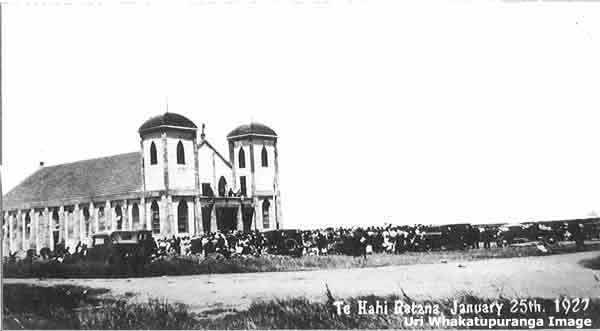
Between December 1926, to January 1927, Ratana’s work was completely dedicated to the construction of the Ratana Temple. The night before the Temple was due to open, T.W.Ratana took his wife Te Urumanao, his sister Raupo, with a group of children too pray inside the new completed Temple. As they gathered around the Throne T.W.Ratana Mangai began to quote scriptures from the Bible readings taken from the Old Testament, and as he spoke, Ratana’s sister turned to Urumanao and the children gathered around the throne, she translated what she heard coming from T.W.Ratana Mangai sermon.
Maori Version (Raupo)
“Whakarongo ki ana korero; e kii ana a iri ko nga piwakawaka whakairo
kei runga I nga paatu nei he rite tonu ki to te Taperanaka o Iharaira.”
English Translation (Raupo)
“Listen, he is saying that the writing and symbols on these walls
are like those that were on the walls of the Tabernacle of Israel.”
Maori Version (T.W.Ratana, Mangai)
“E Ihoa, e Te Wairua Tapu, kua whakaritengia e ahau, nga whakaairo,
nga piwakawaka kei runga i nga paatu o te Tapenekara, (Te Whare O Iharaira)
ki runga ki nga Paatu o tenei to koutou, to matou Temepara. (Te Temepara
Tapu o Ihoa o nga Mano).”
English Translation (T.W.Ratana Mangai)
“Lord Jehovah, the Holy Spirit, I have fulfilled your instructions,
that the structural designs upon the walls of the Tabernacle, (The house
of Israel) be placed upon the walls of this your and our Temple.” (WM Paikea P, 1927: pg2)
The Temple became an a place of worship, in some respects the main lecture hall where Ratana would teach and preach, as with the utilizing of the Marae, Kii Koopu the Picture Hall and Piki Te Ora. By 1927, the "Kura Morehu" was proposed the Church and the Theological College came into full operation with a capacity of 23,000 members that covered the entire country. The Ratana theology is set up with parishes in many parts of the country. All apostleship are issued with certificates to indicate and endorse their duties within the Ratana Church hierarchy. Ratana set up an indigenous certification before any other Maori organization. What Ratana designed back in the 1920-30, have been used today by various Maori organisations. This would give Ratana and his theology school qualification status in the mainstream-learning environment in any academic institute. This enables the Ratana Established Church New Zealand independents to register all its adherents through births marriages and deaths, which produced national data. This was equivalent to a National framework developed by Ratana’s national Kawenata, which he took to the people from 1920, to 1926, which culminated in two Kawenata. One for the establishing of the Ratana Church “Theological College” and the other for the Ratana Federation for the “Treaty University”, whereby through training and learning in both the temporal and secular certificates, licences and accreditation were issued through the Registry Office in Ratana Pa.
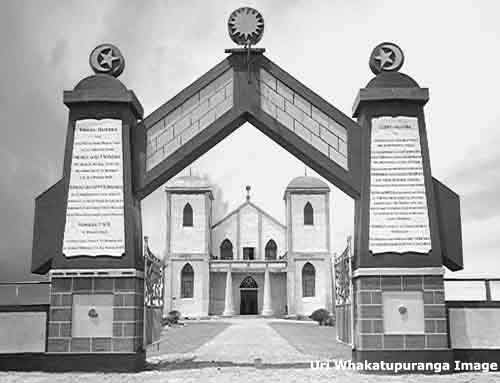
Ratana understood democracy to protect the rights and privileges for Maori (Hapu Whanau and Iwi). The examples Ratana used for democracy, he undertook the task by means to write petitions and covenants as a form of referendums among his Maori people. By using this form of medium, this allowed the people to sign this, which gave him his mandate. In all his work, he always consulted with the people by travelling to every Marae throughout the country to listen to what the people wanted. Every Kaupapa that Ratana designed he would always present it to the people to view it. He would ask the people if they supported it to sign his petition and covenant.
Maori and Japanese People
T.W.Ratana and Bishop Juji Nakada 1927-1928: There were two official openings of the Temple in Ratana Pa. The first opening took place on the 25th January 1927; This opening was spiritual, and opened by T.W.Ratana (Mangai).
The second opening took place on the 25th January 1928, was conducted by Bishop Juji Nakada from the Japan and Tahupotiki Wiremu Ratana (Mangai).
The relationship between these two men was formed during the 1924, world tour when Ratana and his party were delayed by a dock strike in Japan. Bishop Nakada extended an invitation to Ratana and his party to stay at his School of Music at Kashiwagi where a deep bond of friendship and love was sealed between the two men. Ratana expressed to Bishop Nakada and his people the importance of the 8th November 1918, the visitation of the Holy Spirit, and ever since Ratana’s visit in 1924 Bishop Nakada and his people observe and celebrate this important day.
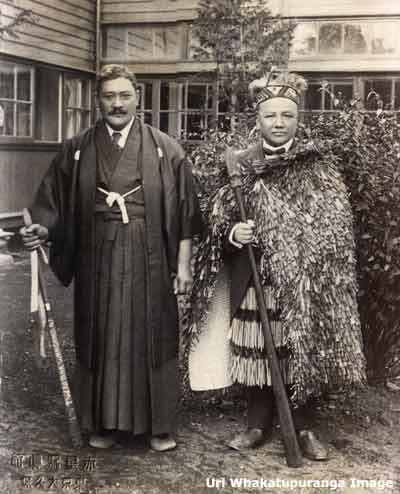
In 1927, all details for the Bishops crusade to New Zealand were prepared. Bishop Juji Nakata wrote to Ratana sending a letter of greetings on the 27th October 1927. In his letter the Bishop began with scripture taken from the Maori Bible.
Bishop Juji Nakata
Maori Version
He Rongo Pai No Te Whenua Tawhiti, Tona Rite Ki Te Wai Matao Ki Te Wairua
Matewai.
English Translation
"Goods News from a far off land is like cold water to a thirsty
soul. (Proverbs 25:25)
These words then heralded the coming of the Bishop and made known his platform of hope, faith and love, but indeed the greatest of these was love. The 20th December 1927, Mr Ratana sent Pepene Eketone, Rewiti Te Whenua and Huia Whenuaroa to Wellington to meet their honoured guest Bishop Juji Nakada and drive him back to Ratana Pa. Their distinguished guest would arrive at 3pm on the 21st January 1928, where Bishop Juji Nakada arrived with his party outside the Temple, where service was conducted inside the Temple. Mr Ratana together with the members of the 1924, World Tour Party and members of the church accompanied them to the courtyard (Marae) by the band (Peene o te Mangai). There were 2000 people waiting on the Marae to welcome Bishop Nakata. Once the formal part of the welcome had settled the Bishop and his party were seated. An Elder rose to conduct the opening speech, which he addressed to greet and welcome the Bishop. In his speech the elder thanked him for the kindness and love he had shown Mr Ratana and his party on their visit to Japan. Once the elder completed his speech, Bishop Juji Nakada rose to reply, to the people on the Marae.
"As I stand here among you, my heart is filled with love for you all as I have hoped and waited for so long to come and visit you! I bring to you Ratana, and to the chosen people under you, the love of the chosen people of the land. Verily I bring sincere greetings to you Ratana, and to your people, greetings, and salutations to you all.”
"When Ratana and his party first meet me, I had not properly re-established my self, or fully recovered from the earthquake which struck me and my people in 1923.” (Akoranga Anaru, 1997: pp59-60)
The Bishop continued commenting that his mother was at the ripe old age of 95 years; she had heard that he was ready to make a mission tour to New Zealand. She confided to he son saying:
“Give my love to Ratana and his people”
His mother then asked her son,
“How am I to manage, and who will take care of me while you are away?”
The Bishop replied,
“My wife, your daughter-in-law will be there to help you, and further, the Lord will be here to take care of you, and should the worst happen, we will see each other again in the presence of the Lord.”
Bishop Nakada’s mother replied to her son
“My son, go into the South, to Ratana and his people; Farewell, I will worry not, nor fret,”
Bishop Nakada became over come by the Holy Spirit, and began to express his sincerity to the people gathered on the Marae.
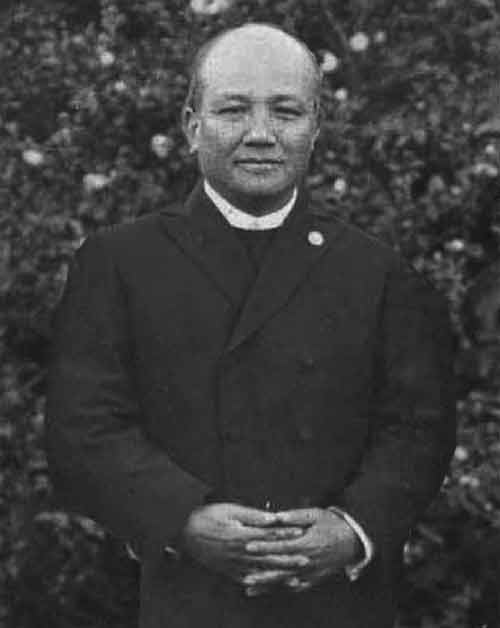
“You who live in this land live under the Star of the South and are shone upon by the sun of the south. As I approached your land in the early hours of the morning, the people who live under that star and here I am with you today. You, who live under the star of the south, have been blessed with the gift of Divine Light and Enlightenment. We, who live under the star of the north, have not yet been blessed with that Divine gift.”
“I therefore urge you to strongly and earnestly pray for my people and me and ask God to grant that we too be blessed with the Divine Light that shines upon you. I again greet you Ratana, and the elders of your party. As I stand here today, I am near to shedding tears, so full is my heart with pleasure and joy.”
The Editor of the Whetu Marama had the privilege to listen and record the following conversation between Bishop Nakada and the local congregation. During these discussions the Bishop said that the population of his country was approaching 80 million, and there are many different churches there in Japan. He said that his Church had been established there for 10 years. There are Churches in nearly every Japanese city where they were training 100 students for the ministry.
There was a young Japanese boy by the name of Kito who came back with Ratana’s world tour party, who also was a student at Bishop Nakata's school for Ministers. Discussions came up about the difference types of food their people ate where the main diet for the Japanese people is rice and vegetables. Compared to the Maori people whose main diet is mainly meat, eels, and other fattening foods. The Bishop said that he noticed how huge in stature are Maori men and woman, which he suggest that they give their rice to the Morehu, and that the Japanese people in turn eat their meat, eels etc so that they might become huge in stature like them. On that note the sound of laughter echoed across the Marae, both men burst out laughing! Bishop Nakada travelled to Auckland for a short tour around New Zealand before heading back to Ratana Pa for the official opening and consecration of the Temple on the 25th January 1928.
T.W.Ratana Mangai
(1928 Temple Opening)
On the 25th January 1928, T.W.Ratana gave the following sermon at the opening of the Temple and its consecration.
“My people the Morehu, if you look at the front door of your Temple you will see a circular emblem there; it is a simple but symbolic illustration of the scheme of things at the beginning of the creation of the universe or space. We humans know not the actual scheme of things at the beginning of Creation, only God (Ihoa) knows. The black dot you see at the centre of the circular emblem represents Satan. Thus you know that Satan was there at the very beginning. from time immemorial, God (Ihoa) was one with the Father, God (Ihoa) was one with the Son, God (Ihoa) was one with the Holy Spirit, and God (Ihoa) was one with the Faithful Angels. Know you therefore, that when you pronounce or call to God (Ihoa), you are in essence, pronouncing or calling to the Father, the Son, the Holy Spirit, and the Faithful Angels. Though this explanation or reasoning, I give you, you will understand more clearly the words and symbols you see in your Temple.”
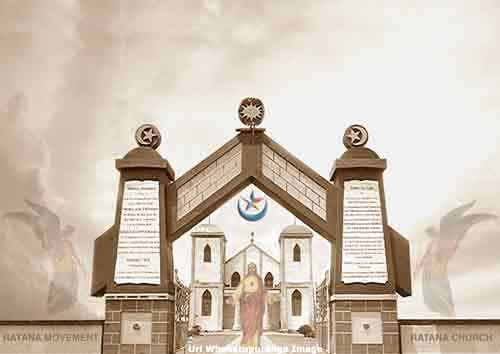
"This name Jesus Christ is one used extensively by the Pakeha as a swear word. Recently I heard one saying by Jesus Christ I'll kill you! This is not the only way his name is blasphemed or used wrongfully, there are many others. That is why I say to you, let us leave this name “Christ" aside in peace and understanding, for others to use; let us, instead, adhere to the Son, a name we have yet to hear blasphemed or used as a swear word” “The Christ I do not deny, I agree and believe in the Christ and his mission on this earth. However, now he has risen to heaven, and is known as the Son of the living Father, the name pronounced at the beginning of Creation. The Christ said I was born even before Abraham and the Prophets. The question then arises whose birth or existence was the Christ referring to? Let me tell you, it was not the birth of his body, that is the Christ, but rather that of the spiritual Son.”
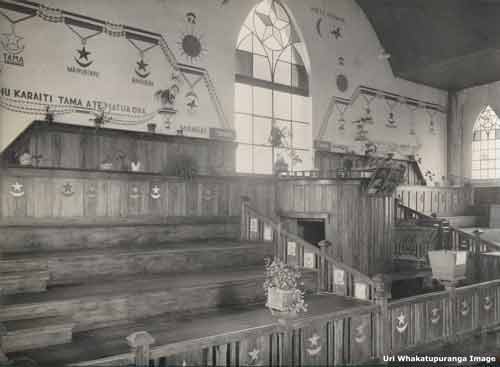
“After the Christ had been baptised he went out into the desert and Satan appeared to tempt and test him. Satan said, if you are the Son of God, command these stones to become loaves of bread. Through this we see that Satan already knew that the Son was the Christ original name. He did not ask, if you are the Christ command that these stones become loaves of bread.” (Matthew 4:3) let us, the Morehu know that truly the Son did descend into the womb of Mary, and when born into this world and living on this earth, he was called Jesus Christ".
It also follows logically that his name should now be the Son, as he has risen into Heaven. When Christ was between 30 and 37 he was crucified as a sacrifice for the sins of the world. He bleed, he was tortured and died, and I tell you, the cross has, and is, cursed and blasphemed. Further the name Christ has been left on the cross, indicating that the Father cursed it, but the Son has risen and is with the Father. Let us abide by these words spoken by Jesus, ‘He who believes in the Son has eternal life, he who does not obey the Son shall not see life, but the wrath of God rest upon him. (John 3:36) And Harken to Christ last words to his disciples, go therefore and make disciples of all ye nations, baptizing them in the name of the Father, Son and the Holy Spirit. Jesus did not say in the name of the Father, and the Christ, and of the Holy Spirit. Today we include in our prayers the Faithful Angels, and so complete that which was left by Christ, thus adding strength to our faith.” (Matthews 28:19) This name Jesus Christ is one used extensively by the Pakeha as a swear word. Just recently I heard one saying by Jesus Christ I’ll kill you"!
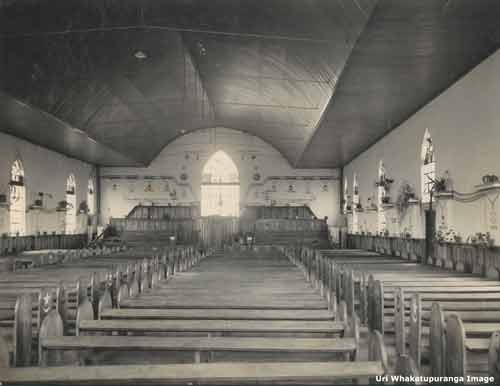
Ihu Karaiti Tama Ate Matua Ora
| |
This is not the only way his name is blasphemed, or used wrongfully, there are many others. That is why I say to you, let us leave this name Christ aside in peace and under standing, for others to use; let us, instead, adhere to the Son, a name we have yet to hear blasphemed or used as a swear word. These things I tell you are not what I have invented thoughtlessly, but as the result of what I have seen and heard. That is why I appeal to the Maori people to unite as one under the powerful hand of Ihoa (God), the Father, the Son, the Holy Spirit, and the Faithful Angels.” This Maramatanga did not just happened, or come in an ordinary manner; neither did I seek it through study of knowledge. On the contrary, this Maramatanga, in truth, came from above, from the Father, the Son, Holy Spirit, from the Faithful Angels, and from the Mangai who is speaking to you In addition, it is recorded in the Scriptures, my Father has delivered all things to me; and no one knows the Son except the Father, and no one knows the Father except the Son and anyone to whom the Son chooses to reveal him. (Matthew 11:27) |
| |
“I will not allow Gods word and Gods Maramatanga to be twisted, or spoilt, to please or benefit the physical person, only the Spirit preaches good and truth and I shall not preach in a manner designed to make what I teach pleasing to those who look and listen, just for the sake of pleasing them, or to gain rewards for myself personally. If I were thinking of personal gain or seeking a high place for myself, I would have sold myself to the world long ago. I have never put my family first; on the contrary, when I received this Maramatanga I travelled the whole land spreading it abroad among Maori people and the result is that you, the Morehu, are a united people in the glory of Ihoa (God). Verily, you, the entire Morehu, have been blessed with that glory, as an extension of the love of God that was placed in my hands. That is why you are faithful to me, and will uphold what I teach you. |
Sacred Icons
What is a sacred icon; what does a sacred icon represent to people from different cultures and backgrounds and the effect they have on people today. An icon can represent a religious subject; its historical and theological roots can explore the spirituality that has drawn countless of believers to its spiritual inner beauty with the use of colour, shape and symbols to discover ways of enhancing ones faith.
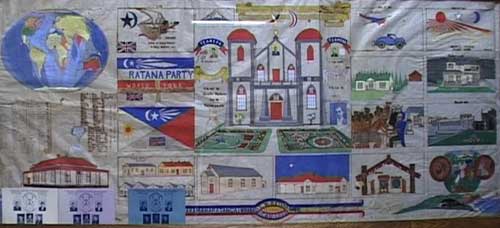
Sacred images reflect its sacredness symbolism that usually depicts the history, theology, and teachings of the Church in some cases cultural history. The Ratana Movement and Ratana Church have many icons in its theology; these icons have various interpretations explaining spiritual prophecy. (Sacred Icons Ratana Movement and Church Hagger.A.R:2003)
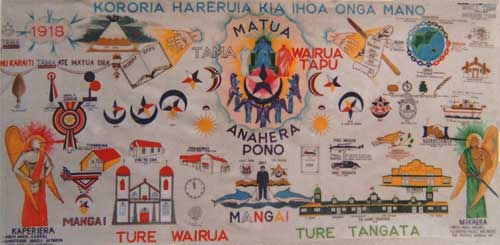
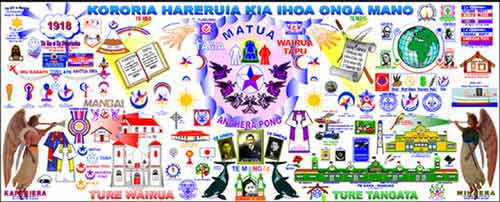
The icon symbolic imagery portrays spiritual beauty, not physical sensuous beauty as is often shown in religious art. These are not religious art but is visual theology revealing the word of God. This shows the true transfiguration and sanctification to operate, the creation by God the Father, the Son, Holy Spirit, and their Faithful Angels. These are not mere depictions of the teachings of the Mangai, but are Jehovah’s greatest revelations delivered by his servant Tahupotiki Wiremu Ratana, empowered by the Holy Spirit, to manifest the works via the Mangai and Piri Wiri Tua.
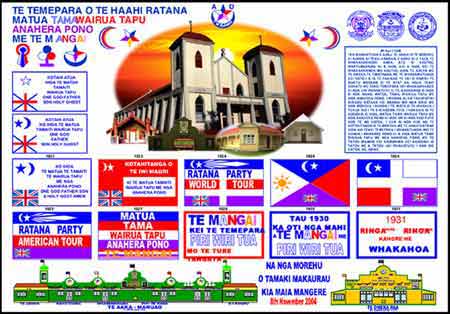
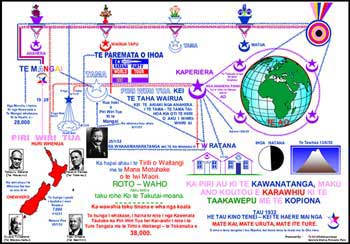
Maori used many types of symbols to depict their cultural heritage reviving canoes, kowhaiwhai, weavings carvings that are prominent in the Maori culture. This form of symbolism would represent their whakapapa (genealogy) giving a concise history that could recite back to the beginning of creation. Maori carving is used as a form of historical record dating back 500 years. These carving materials were wood, jade and born. Maori Whakapapa include not just the genealogies but also the many spiritual realms and mythological and human stories. This form of knowledge would be handed down to succeeding generations in several forms that included oral history through human presentation delivery. There were haka (dance), waiata (song), tauparapara (chant), karanga (chant), paki waitara (stories), poroporoaki (farewell), whakapapa (genealogy) whakatauki (proverbs) and pepeha (tribal sayings), are retained and learnt. There is Greenstone very precious to the Maori people of the South Island. The Greenstone to Maori traditions is to do with the West Coast of the South Island. This form of stone is related to jade and is called Pounamu in Maori. (Karetu, King M: 1975)
Symbols in the Ratana Movement and Church
In one of T.W.Ratana Mangai’s speech, he explained about the sacredness of the symbols on the Temple wall. The circular emblem represents a simple symbolic illustration of the scheme of the beginning of Gods creation of the universe or space. He continued by saying that the black dot in the centre of the circular emblem represents Satan. Satan was there in the beginning of creation before he fell from grace, thus God was one with the Father the Son and the Holy Spirit, and his faithful Angels. The black dot was removed from the inner circle to the outer circle. When you enter the main doors of the Temple looking upwards above the doors, you read the inscription “Ihoa Onga Mano Whaioio” (Jehovah of the Multitudes). Just above the window, you will find one of the most important emblems in the Ratana Movement and Ratana Church “Te Kanohi a Ihoa” The Whetu Marama O Te Kotahitanga explains a brief explanation concerning the Kanohi O Ihoa. (WM 28th Jan 1928; Akoranga, Anaru, 1997: pg61) (Oral History 1983) (WM No.1215: 1969; WM No.1218, 1969: pg6; WM No201, Paikea P, 1928: pg4; Sacred Icons Ratana Movement and Church Hagger.R.A, 2003; Melnick Robert: 2003)
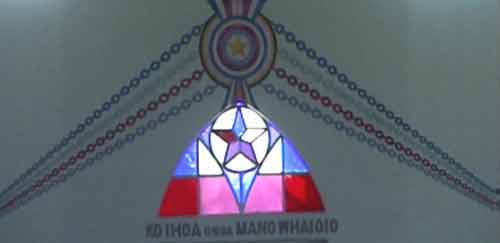
The Temple is the most sacred building erected in Ratana Pa. This building has become the sanctuary place of worship, the central focal point for the Ratana faith today. Many sermons have been delivered by T.W.Ratana Mangai who conveyed that the Temple is the place where God’s spirit dwelled. These images and designs on the Temple wall represent the heavenly realm of the conception of God the Father, the coming of the Son who descended from the throne of God to be conceived in the womb of Mary, to be born into the world as a physical man known as Jesus the Son of the living God. Ratana Church carries many symbolic icons. These icons also come in the form building, symbols, flags and banners that depict spiritual divinity to the people. Te Piki Te Ora was used as the early focal point for Ratana’s ministry. This building was used for Church services, healings, and fellowships. People would congregate in this building to hear T.W.Ratana Mangai deliver his message. In this building many religious debates took place where the sharing of spiritual knowledge was depicted by means of oral delivery, musical presentation, healings that required spiritual and physical deliverance. The out-pouring of the Holy Spirit manifested miracles became transparent to the congregation. The Piki Te Ora was transformed into a hospital and the latter years and became the official Church office. This building became an icon to the people; this made the invisible reality visible, revealing the spiritual ore and the presence it carried within the building. (Sacred Icons Ratana Movement and Church Hagger.R.A, 2003; Melnick Robert: 2003)

T.W.Ratana Mangai did illustrate the biblical history, theology and teachings from a spiritual and physical perspective. He displayed this through using various symbols and icons, such as stars, crescent moons, linked chain’s and many other symbols that were used during his twenty-year ministry. This medium allowed the invisible world, to become visible, therefore accordingly to fully understand one must look at them with spiritual eyes. This would unveil the hidden mystery revealing the spiritual world we cannot see with our natural senses. These spiritual icons are likening to a “window” made transparent looking into the kingdom of God. They capture this spiritual reality of the invisible world like a door of perception natural by the power of the Holy Spirit. In the Old Testament God used numerous opportunities to make use of visual, symbolic imagery. For example, God made man in the image of God (Genesis 1:26). He ordered his people to fashion the Ark of the Covenant with the image of two Angels, one on either side of the glory seat. God instructed the Jews to decorate it with ornate Angels and other heavenly beings. (Exodus 20:1-26). This Banner carried by the Raupo Roopu depict spiritual imagery that illustrates a believer can have a spiritual experience with the living God via the sacred icon. In 1937, the white dove was used on the Raupo Roopu banner, the clock was also used on the banner to support its message God is the author of time. The New Testament naturally adopted this heritage of visual imagery. It is true that God prohibits the worship of false gods in the form of graven or carved images, because this leads people away from the one true God. If an image brings the believer closer to the true God then we call it a sacred icon (not idolatry), which is worshiping a false man, made God. (Sacred Icons Ratana Movement and Church Hagger.R.A, 2003)
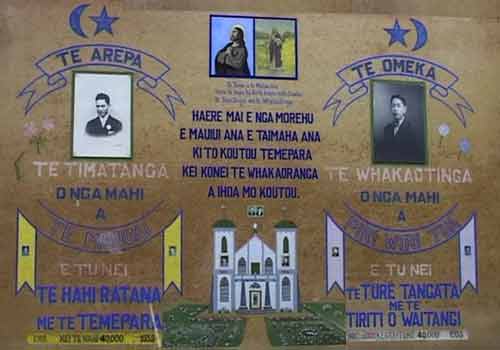
During Ratana’s early years of his ministry he used various types of iconography that were designed to illustrate the Maramatanga and the works therein. Most of his sermons were usually spoken in Maori, from his oral sermons he was able to cross the medium by using music, kapahaka, displaying banners flags and flat graphic, with the use of colours in uniforms worn by the followers who had different positions in the Church hierarchy.
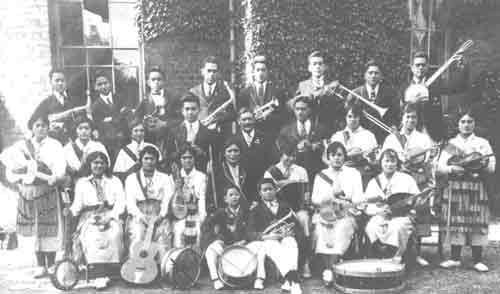
This would deepen their faith and devotion to enrich their daily prayer. These icons became an important means of understanding the teachings the theology within the Ratana Movement and Ratana Church. In all his works, T.W.Ratana never used Maori carvings to depict the teachings of the Maramatanga. He educated the people not by theory but mostly by example via means of verbal or imagery deliverance. The imagery medium was aimed to capture the choice of colour and sound the expression and composition that depict their spiritual essence. The use of icons in the Church today was not a mere choice of aesthetics, but of deep theological conviction.
T.W.Ratana was able to use these form of mediums to reveal the history of the faith. The goal for the Ratana Movement and Church is not to portray its “objects” and “inhabitants” but rather, their place and true meaning in this world according to the views portrayed and delivered by T.W.Ratana through the Mangai/Piri Wiri Tua, revealing the great revelation of Jehovah’s Maramatanga to all Mankind.
T.W.Ratana Mangai, Piri Wiri Tua became a scribe and teacher who delivered the spiritual teachings to portray Divine Enlightenment using various symbols to allow his people to understand. Therefore, he transferred its content the written word as if an artist takes up his brush and faithfully portrays the subject transforming the sacred icon into reality. Throughout church history, there have been numerous accounts of miraculous events occurring in association with certain icons. In the Son of God, the invisible God becomes visible; when one sees his Son, you see the Father (John 14:8) (WM Te Tai: 1926; Sacred Icons Ratana Movement and Church Hagger.R.A, 2003; Melnick Robert: 2003)

Manuao
When the Manuao was opened and consecrated on 11th September 1938, T.W.Ratana explained to the people, the Manuao carried great significance spiritually and physically. Mr Ratana explained the Manuao would become shelter and strong hold in the battle of the spirit, and that the power of the Holy Spirit dwelled within. The Tiriti O Waitangi “Covenant”, Mauri (life-force) was also laid in the covenant foundation when the Manuao was consecrated and erected. The Manuao carries the Seven Canoe’s including the Endeavour and the Heemskerck. Ratana referred to the waka’s mounted on the Manuao veranda as lifeboats, spiritual lifeboats. (WM Tane M,1938: pg2)
“Oh Jehovah, we place before you our petition, before you and your Government, (he is referring to a spiritual government) as your parliament has now been established on your sacred mountain here in Ratana, and because also the Treaty of Waitangi is your treasure given to us; we pray that the Treaty of Waitangi be returned here to your parliament which has been established here, that it may be finally ratified. We ask that all matters concerning the spiritual works and the physical works be brought back here to your parliament for discussion and decision.” Oh Jehovah, you are the author, and the judge and the law. (WM Te Tai: 1928; Akoranga, Anaru: 1997)
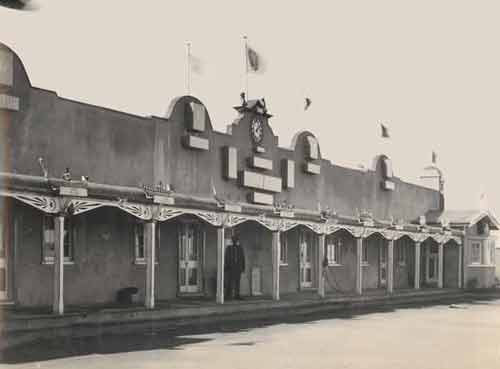
Many theological ideas are attached to the Zion as it develops through the history of Israel’s redemption. The idea of Zion as the dwelling place of God, the place where God is in the midst of his people, is joined to the larger theme of Immanuel, “God in our midst.” In the same way that the pillar of fire and cloud stood above the tabernacle during Israel’s wilderness wanderings God would dwell in Zion. (Deuteronomy 12:5-14). When Jerusalem became David’s capital and Solomon had completed the temple, the cloud of God’s glory filled the temple (1 Kings 8:10 and 2 Chronicles 5:13-14) and Jerusalem became the dwelling place of God. (Psalms 74:2; 135:21) (Isaiah 76; 8:18) (Joel 3:17-21).
The Lord loved and chose Zion (Psalm 78:68) (Psalms 132:13). His glorious presence was there, and he would speak from there (Psalms 50:1-2).
His fire was in Zion and his furnace was in Jerusalem (Isaiah 31:8-9). In Zion, he was enthroned above the angels (Psalms 9:11) (Psalms 99:1-2),
and he ruled over his people and the nations (Isaiah 24:23). God’s chosen king ruled from that holy hill. (Psalms 2:6; 48:1).
The prophets describe it as “chief among the mountains, raised above the hills” (Isaiah 2:2 and Micah 4:1). The Canaanite idol, Baal, was thought to dwell on a great mountain to the north, Mt. Zaphon, so the writer of the Psalms describes Zion as “beautiful in its loftiness”, like the utmost heights of Mt. Zaphon” (Psalm 48:1-2). God’s sanctuary is “like the high mountains” (Psalm 78:68 and Ezekiel 40:2).
During the Old Testament period, the city’s water came from one small spring.
But in the eyes of the poets and prophets, Zion is blessed by a great river that brings life wherever it flows. (Psalms 46:4) (Ezekiel 47:1-12) (Joel 3:18) (Zechariah 13:1) (14:8 Revelation 22:1-2). The threatening waters of chaos cannot shake the city of God (Psalms 46:1-3). Because Zion is the city of God, it is the destination of pilgrims, Jew and Gentile alike, who long to be in the presence of God (Psalms 42:1-2; 63:1). All humanity will come to God in Zion (Psalms 65:1-4).
The Gentiles will make annual pilgrimages bringing gifts (Psalm 76) (Isaiah 18:7) (Zephaniah 3:9-10). Even former enemies will be thought of as native-born citizens of Zion (Psalm 87:1) (Isaiah 60:14) (Zechariah 14:21). The nations will stream into Jerusalem to begin an era of peace (Isaiah 2:1-5 and Micah 4:1-8). Year after year, the festivals of Israel will be celebrated by Gentiles in Zion (Zechariah 14:16-19).
The New Testament also looks forward to the re-creation of heaven and earth and the creation of a New Jerusalem that will happen at the end times (Revelation 21:2). At this time, Zion will be a city on a great high mountain (Revelation 21:10) (Psalm 48:1-2; 78:68) (Isaiah 2:2) (Ezekiel 40:2) (Micah 4:1), and a river of life flows within its walls (Revelation 22:1-2).
T.W Ratana’s ministry and prophecies depict these prophetic words from the Old Testament, New Testament and the Book of Revelations. In all his works, he used two foundations to spread the Maramatanga enlightenment for humanity
Ture Wairua (Spiritual works); Ratana Pa (Te Arepa) the Spiritual Pa, which deals with the spiritual works.

Ture Tangata (Physical works); which deals with the physical works (Omeka Pa) concerning the Tiriti O Waitangi
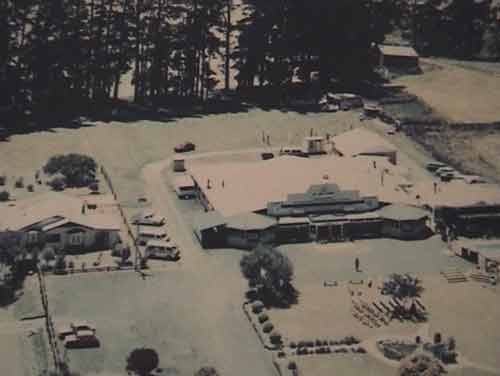
First Kawenata T.W.Ratana
Te Mangai (1920)
During his ministry, Ratana brought forward two special Covenants. The first in 1920, and the second in 1924. T.W.R.Mangai 1920, Covenant for the Maori people dealt with the confession of the wrongs of the Maori people who were dwelling in Tohungaism “to work and tear down and cast aside all tribal barriers and jealousy which was rampant through Maoridom. The Tohunga on the other hand used their wizardry power which some Maori believed could help them through their trouble times, due to the declining standard of living, their physical and social and spiritual problems. T.W.R.Mangai stated clearly there is no room for this kind of practice but Maori continued to consult the tohunga hoping their solutions would disappear but unfortunately, the Tohunga using the ancient arts found their spells powerless to protect the Maori from the new strains of diseases.
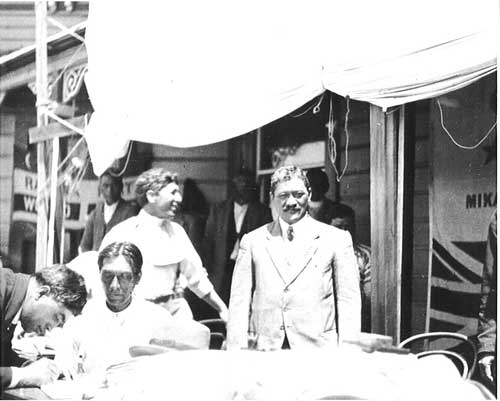
However the passing of the Tohunga Suppression Act 1907, the Tohunga still practiced their craft as the Maori people were now looking for a divine power to release them from their old ways of Maori beliefs and superstitions. This cleared the way for T.W.Ratana Mangai to preach the good news remove the doubt and superstitions from his converted followers Although the first covenant in 1920, dealt with the confession of the wrongs of the Maori people who were dwelling in Tohungaism, which had begun in the days of their ancestors, Maori had to make a pledge that in the future, reject all wrongs or evil practices. Maori were invited to freely choose to support the covenant by signing their names to it. This was made very clear to the Maori people that they had to with profound sincerity and with unswerving loyalty agree with the terms that were written in the covenant.” The Maori people had to make a promise they would pray that God would be their protector and refuge forever and ever, and to accept the teachings they would work for the glory of God only, and for the good of all humanity. Those covenants were made clear to the people throughout the land.
To unite under God of the Multitudes (Ihoa Onga Mano) and to acknowledge that God is the power and authority over all things, and in doing so, that God is their protector and refuge in which they were willing to put their trust forever and ever.
To repent before God and ask forgiveness for the wrongs they had done
In return for God agreeing to be their protector and refuge to worship no other God and to join Tahupotiki Wiremu Ratana in spreading the good news of God’s power and glory and great love.
To work to atone for the wrongs of their ancestors
To cast away the shackles of the evils of corruption, tohungaism, devil worship and witchcraft, which had become rife among them
To work to tear down and cast all tribal barriers and jealousies and instead to live together as one family of Remnants
(Editor WM Te Tai I, 1925: pg2)
The second covenant was launched in 1924, reaffirming Maori their pledge to unit under one God, and for those who also missed out in signing the first covenant in 1920. The second covenant was closed Easter Monday 21st May 1925, at Ratana Pa. A total of 21,932, and 1009, that were included by proxy. T.W.Ratana Mangai told his followers to remember there the bible on one side, and the Treaty of Waitangi on the other side. Now that we have be sealed as the children of God. This covenant was looked upon as the signal for the path that was set for the Morehu (Remnants) both in the works of the spirit and the works of the physical realm (Ture Wairua, Ture Tangata). Many of the old customs where being abolished and new teachings were being introduced into the Maori way of life. Ratana’s concerns were about his people having good health, strength, enlightenment, and divine peace that they would individually seek for themselves. Ratana always encouraged his people to strive and overcome all obstacles.
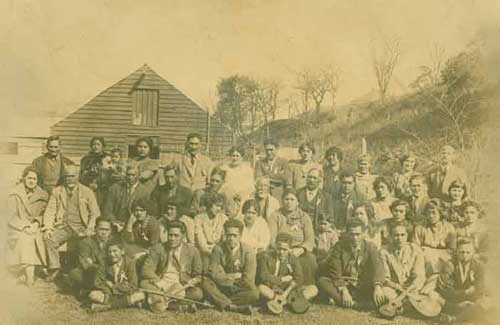
The Maori people were slowly starting to make progress for the common good, as Ratana always wanted then to all unite as one people of the land. He warned then not to create divisions among them selves and stop building fences between them because there would be no progress and Maori will once again return to their past. He always preached that those who do the work of this Maramatanga, God would reward them in the spirit, unless the people would rather prefer the rewards of the material world, because they can actually see what they are. It is interesting to know that these covenants were similar to that of the people of Israel, their ancestors. The Maori people had to cast away all worship of false Gods, Tohungaism and tribal jealousies that had kept them divided. (Akoranga Anaru, Page 1997: pg45)
“And Moses called all Israel and said unto them, Hear, O Israel, the statutes and judgements which I speak in your ears this day, that ye may learn them, and keep them, and do them.
"The Lord our God made a covenant with us in Horeb.” (Deuteronomy 5:1-3) “The Lord made not this covenant with our fathers, but with us, who are all here alive this day.” (Ex.9: 5)

“And God saw that the wickedness of man was great in the earth, and that every imagination of the thoughts of his heart was only evil continually.” (Genesis 6:5) “And the Lord said I will destroy man whom I have created from the face of the earth, both man and beast, and the creeping thing, and the fowls of the air; for it repenteth me that I have made.” (Genesis 6:7)
Noah was a just man who believed and walked with God and who obeyed God in every manner. God spoke to Noah telling him that he was going to bring a flood of water upon the earth to destroy all flesh, and that every thing that is in the earth shall die.
“But with thee will I establish my covenant; and thou shalt come onto the ark, thou, and thy sons, thy wife and thy sons wives with thee.” (Genesis 6:18) “And every living thing of all flesh, two of every sort shalt thou bring into the ark, to keep them alive with thee; they shall be male and female.” (Genesis 6:19) “Thus did Noah; according to all that God commanded him, so did he.” (Genesis 6:22)
“God spoke to Noah saying, "And I will establish my covenant with you; neither shall all flesh be cut off any more by the waters of a flood; neither shall there any more be a food to destroy the earth.” (Genesis 9:11)
“The Covenant between God and Noah, where God set a rainbow in the cloud as a token of his covenant between him and Noah and the earth, so that it would be remembered that his covenant between himself, and all living creatures, that there will never again be a flood that would destroy all flesh. The rainbow in the cloud was God’s promise of his ever lasting token and covenant, which he has established between him and all flesh that is upon the earth.”

“God spoke to Abraham saying, and I will make my Covenant between me and thee, and I will multiply thee exceedingly.” (Genesis Chapter 17:2) “And Abram fell on his face: and God talked with him, saying.” (Genesis 17-3) “As for me, behold, my Covenant is with thee, and thou shalt be a Father of many Nations.” (Genesis 17:4) “Neither shall thy name any more be called Abram, but thy name shall be Abraham; for a Father of many Nations have I made thee.” (Genesis 17:5)
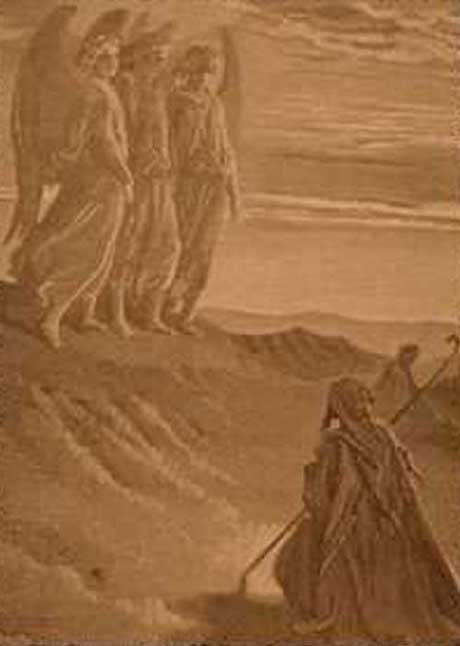
Described as a wooden chest covered with gold. It had two tablet stones that therein were placed the Ten Commandments and was often called the Ark of the Covenant (Barlow C, Holy Bible: 1992)
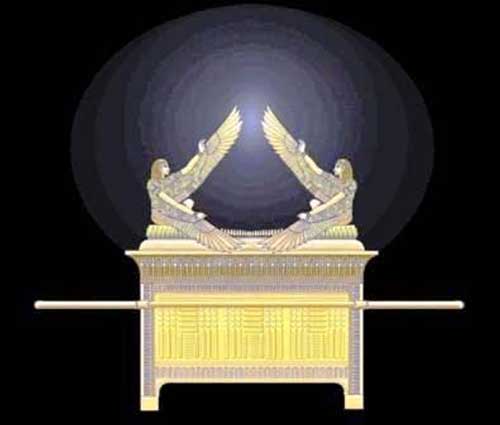
Mangai Kawenata
T.W.Ratana Mangai bellieved his Sacred Covenants for Maori were very important, he always believed that a covenant between God and the Maori people should be acknowledged and they would abide by those sacred deeds written up in that covenant like their ancestors of biblical times. A Kawenata was also drawn up for the builders who were working on the Temple in 1926, for their protection to complete Jehovah's Temple.


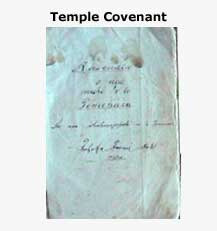
Under construction to be continued...
|
|
|
|
|
|
|
|
|
|
|
|
|
|
|
|
|
|
| |
|
|
|
|
|
